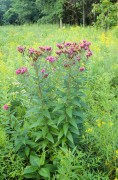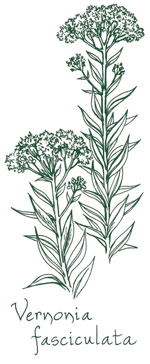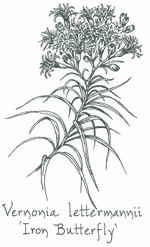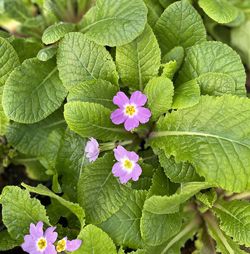Vernonia
Culver's Root
These vigorous American denizens promote an obliging stalwart demeanor plus welcome late summer flowers. A nectar feast for the butterflies, Vernonia can be peppered throughout meadow plantings and native landscapes, accompanying chums such as Helianthus ‘Lemon Queen’, Eupatorium ‘Riesenschirm’ and Sporobolus ‘Tara’.
A robust presence, unsurpassed late fall color and a compelling winter silhouette are this North American prairie dweller’s claim to fame. Painted with opulent crimson-purple hues, the flat branched heads of Aster-like flowers surmount proud stiff stems and long lance-shaped, rough-to-the touch green leaves. A finale of fluffy white seed heads matures to a rusty orange, earning its common name, while the genus pays tribute to William Vernon, a British botanist who collected the species in Maryland in 1698.
Clump-forming Ironweed is well-suited for a modern meadow-style theme, holding its own amongst bold, green bladed Miscanthus or more airy Molinia or tall perennials like Helianthus ‘Lemon Queen’ and Aconitum. Beloved by bees and butterflies everywhere, it’s easily cultivated, appreciating a well drained moderately moist site.
Blooms August – September.
Size: 5' 0" high x 12" – 2' 0" wide.
Hardy to zone 5.


Venerated for its iron-related traits including arrow-straight brawny stems, fluffy warm rust-tinged seed heads and a rugged constitution, this easily grown late bloomer roams the moist prairies from Ohio to North Dakota and south to Missouri, Oklahoma and Texas. Glabrous green linear leaves line smooth stalks, rendering a brilliant purple burst of densely clustered composite flowers that hosts the American Painted Lady butterfly. Its substantial hard-working presence can be featured in informal borders or meadow-style settings and ensconced with Sanguisorba 'Chocolate Tip', Eryngium yuccifolium and native grasses.
Blooms July–September
Size: 2' 0" – 4' 0" high x 18" – 3' 0" wide.
Zone 3/4.
Vernonia lettermannii (P-2195)
Each $11.00
Wandering amidst Arkansas and Oklahoma’s rocky outcrops and flood plains, this graceful easy-care perennial pays homage to George W. Letterman, a highly regarded loner-type botanist who scoured the Missouri Ozarks searching for unusual plants. Vernonia lettermannii’s steadfast taproot sends forth well-branched, sturdy upright stems cloaked with ultrathin lanceolate green leaves, while hundreds of close-knit royal-purple flowers, held in countless small clusters, roost above. Relished by bees, moths, skippers and butterflies, the late summer flowers plus soft-looking deer-proof demeanor can stabilize slopes, garnish a cut arrangement or enhance water-wise gardens, natural-style plantings and perennial borders. Sunshine galore, sharp drainage and moderately moist to dry soil ensure its prismatic fine textured allure.
Blooms August–September
Size: 2-1/2' – 3-1/2' high x 18" – 2' 0" wide.
Hardy to zone 4.

We owe a round of applause to Dr. Allen Armitage for his University of Georgia plant trials, which produced this highly acclaimed selection of Arkansas resident, Vernonia lettermannii. Distinguished by dainty-looking thread-like green leaves, the robust, yet compact, attractively branched mounding habit affords small, tubular bright purple blooms housed in showy terminal sprays. Possessing both a herculean mettle and ultrafine texture, ‘Iron Butterfly’ demands free-draining niches, extends seasonal interest with warm rusty-toned autumn flowers plus triumphs over hot dry conditions as well as sandy, infertile rock-strewn sites.
Blooms August–September
Size: 2' 0" – 3' 0" high x 18" – 2' 0" wide.
Hardy to zone 4.
A flashy new 2014 Jelitto Seeds introduction, this quibble-free white-blooming version of New York Ironweed propels erect upright stalks, densely cloaked in serrated, lanceolate green leaves, buoying fluffy delicate plumes of narrow-petaled creamy-white daisies. Followed by decorative seed heads, the long-lasting late season blooms make bright additions to cut arrangements and entice many garden visitors, especially bees and butterflies. ‘White Lightening’s clumping bushy habit can be massed or planted as a striking focal point for a somewhat informal venue, where it will readily adapt to variable conditions.
Blooms August–October
Size: 6' 0" high x 2-1/2' wide.
Hardy to zone 4.
Hats off to esteemed plant breeder Jim Ault from the Chicago Botanical Garden for this winning midsized Vernonia lettermannii and Vernonia angustifolia hybrid. Composed of thin violet-tinged olive-green leaves, the bushy fine-textured habit promotes an overall rich rubescent tone beneath copious deep purple flowers. Steadfast long branching stalks are uniquely intertwined and remain upright, even during storms, while supporting plump capitula packed with late season, long-lasting florets that tantalize bees, moths and butterflies. Adaptable to moist and dry conditions, ‘Summer’s Swan Song’ can be utilized singularly or planted en masse in well-drained mixed borders, pollinator gardens and near water’s edge, where it boasts impressive rust and mildew resistance. (pp#28,556)
Blooms September–October
Size: 2-1/2' high x 2-1/2' – 3' 0" wide.
Hardy to zone 4.










